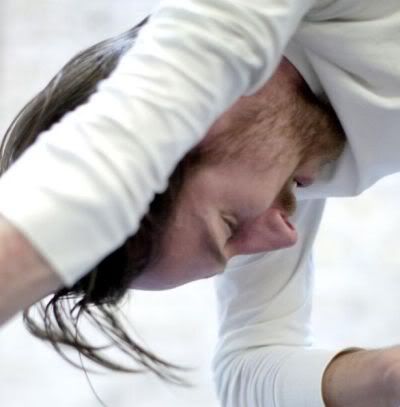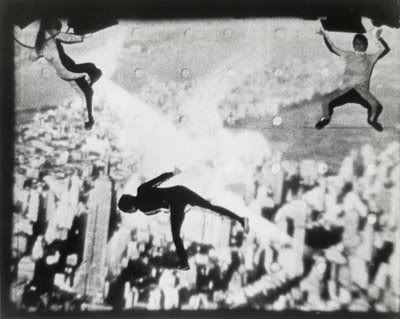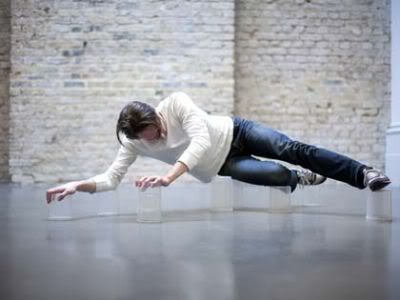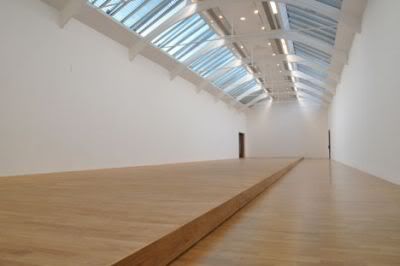Hot Coals
One of the things that continues to fascinate me about performance work is the act of evading space, of achieving some kind of ownership or transgression of an environment in the name of difference – a wilful separation from existing modes of ‘objectness’ or for the sake of amour - the exploration of a new kind of (e)motion.
This comes through particularly in the trio of works by Trisha Brown on show intermittently at the Barbican as part of the excellent Pioneers of the Downtown Scene exhibition; Walking On The Wall (1971); Planes (1968) and Floor of the Forest (1970).
Floor of the Forest
Also in the Whitechapel Gallery the commissioned collaboration between Siobhan Davies and Matthias Sperling in response to Clare Barclay's installation Shadow Spans in which the dancer propels himself methodically across the gallery floor, supported by a series of ‘temporary archipelagos’ in the form of upturned plastic pots - each one corresponding to a point on his body and keeping him from the floor.
All of these works seem to play with evasion; the desire to avoid the concreted preconceptions that become attached to a work when it is placed in a conventional gallery setting by striving to break corporeal contact with that setting. In conversation at the Whitechapel, Sperling discussed the very different plane upon which he exists within the piece thanks to these ephemeral plinths. He disconnects from the curious and brilliant objects fashioned by Barclay and occupies instead a kind of hinter - space within the space; one in which he can perhaps begin to make new meaning.
In Trisha Brown's pieces there is more of an interaction at work, or at least the traces of tension left in the process of transgressing the architecture.
In Planes, the three climbers grapple and hang, higher and higher, but they remain unwittingly implicated in the projected imagery that relentlessly pervades the piece; meaning is literally projected on to them. In Floor of the Forest, in parallel with the Davies/Sperling work, the task is one of endurance and evasion, but the bodies are inexorably entangled in the ‘object’ of the work.
Walking on the Wall feels like the key work among all of this. The gesture is very simple but paradigmatic relational dynamics are both splintered and enhanced by it. Both audience and performer find themselves in a space of ‘objectness’ by virtue of the inversion, the suspended bodies hang framed on/by the gallery walls and the audience are left central and solitary in the accustomed performance / installation space.
This echoes somewhat in Bethan Huws current transformation of one of the Whitechapel’s upstairs galleries.
Capelgwyn (2011)
Exposing the architecture of the space places us as viewers in an uneasy state of expectation, gradually realising on the calm walk through the gallery, our own spectacular status.
But back to the idea of amour/love/e(motion). These are all devotional acts of endurance; while watching them all there is both the tantric thrill of what seems a trial by fire, the artistic promise or desire to make it through no matter what, coupled with this corporeal/architectural thrill game of touching but not touching. I’m increasingly interested in the characterisation of artistic/authorial impulse in terms of love – from the employment of the Freudian Fort Da - to fandom and fetishes in performance - to Della Pollack’s Love/Lack dichotomy in performative writing.
To repeat the quote that hinges Pollack’s text…
“We are all in a position of ravishment – call it lack, if you must; our only hope for survival – call it love – being, against all odds and through all divisions, to keep on writing.” *
…or to reach the other side of the floor, to hang tight, to keep moving.
* from Subversive intent: gender, politics, and the avant-garde by Susan Rubin Suleiman. Quoted in Della Pollock Performing Writing (1998).
Some background on the Barbican Exhibition here.








Comments